

Automated Detection of Server Configuration Drift
Mon, 17 Aug 2020 18:44:45 -0000
|Read Time: 0 minutes
Automated Detection of Server Configuration Drift
Security and compliance are key design principles of Microsoft Azure Stack Hub. The Dell EMC Integrated System for Microsoft Azure Stack Hub is engineered to meet Compliance, Regulatory, and Policy requirements of our customers.
Security posture on Dell EMC Integrated system for Microsoft Azure Stack Hub is implicit to our automated lifecycle management. Our goal is to extend and complement Microsoft’s strategy of baselining and remediating their security posture with a comprehensive drift and remediation strategy for all of our Azure Stack Hub elements.
The Automated Server Config Drift Detection feature, enabled on Dell EMC OpenManage Enterprise as part of the Dell EMC Patch and Update Automation - 2004 Release, ensures Configuration Compliance as instituted by Microsoft and Dell EMC.
Monitor & Detect, Notify, and Remediate Server configuration Drift on Azure Stack Hub are the three key outcomes of the Automated Server config drift detection feature.
- Compliance Monitoring is kicked off by automated discovery of HLH and Scale Unit nodes on Dell EMC OpenManage Enterprise (Figure 1, below).
- Configuration integrity is maintained by enabling compliance baseline templates for the HLH and Scale Unit Nodes on OpenManage Enterprise in order to track drift (Figure 2).
- Customers can view Compliance reports which display whether Server settings conform to the configuration baseline or not (Figure 3).
- Drift from any of the Server settings applied at initial deployment on the HLH or Scale Unit nodes will be automatically detected, resulting in the node being tagged as Non-Compliant (Figure 4).
- Server-drift Notification Alerts generated on OpenManage Enterprise are sent proactively via Dell Support Assist Enterprise (SAE) to Dell Technologies support.
- Customers can call Dell EMC Support to remediate non-compliance to ensure that the health and compliance status of their Azure Stack Hub continues to stay green.
Figure 1: Monitor HLH and SU nodes discovered on OpenManage Enterprise for alerts
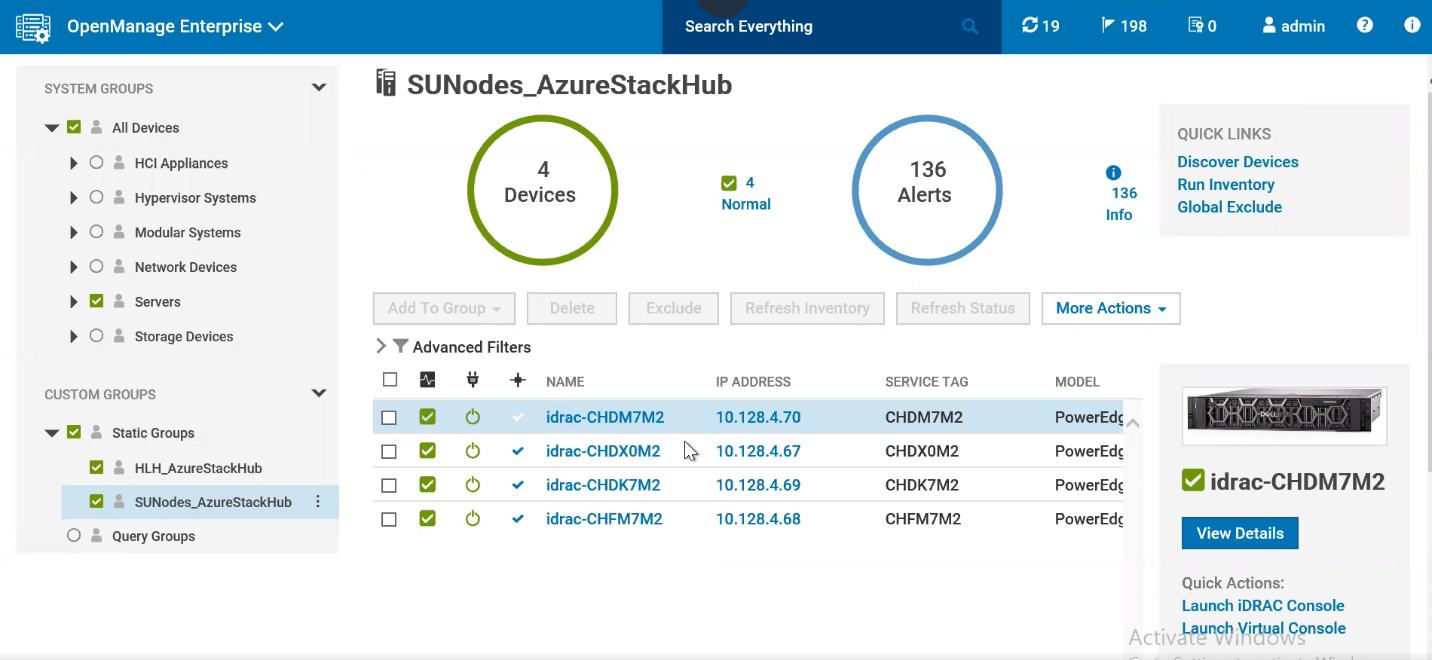
Figure 2: Configuration Compliance status of HLH and SU nodes against configuration baseline
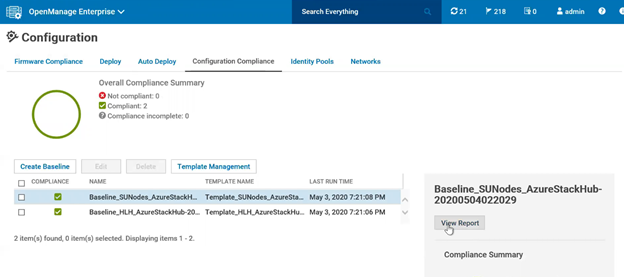
Figure 3: Compliance report indicating SU Node level Compliance status
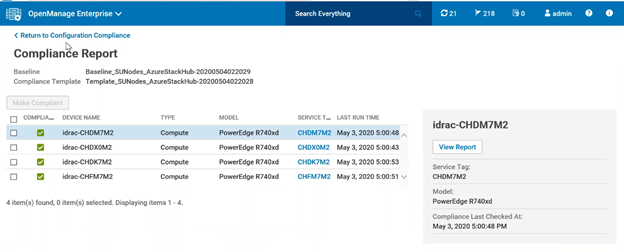
Figure 4: Drill down view of Compliance report in case of Compliance failures
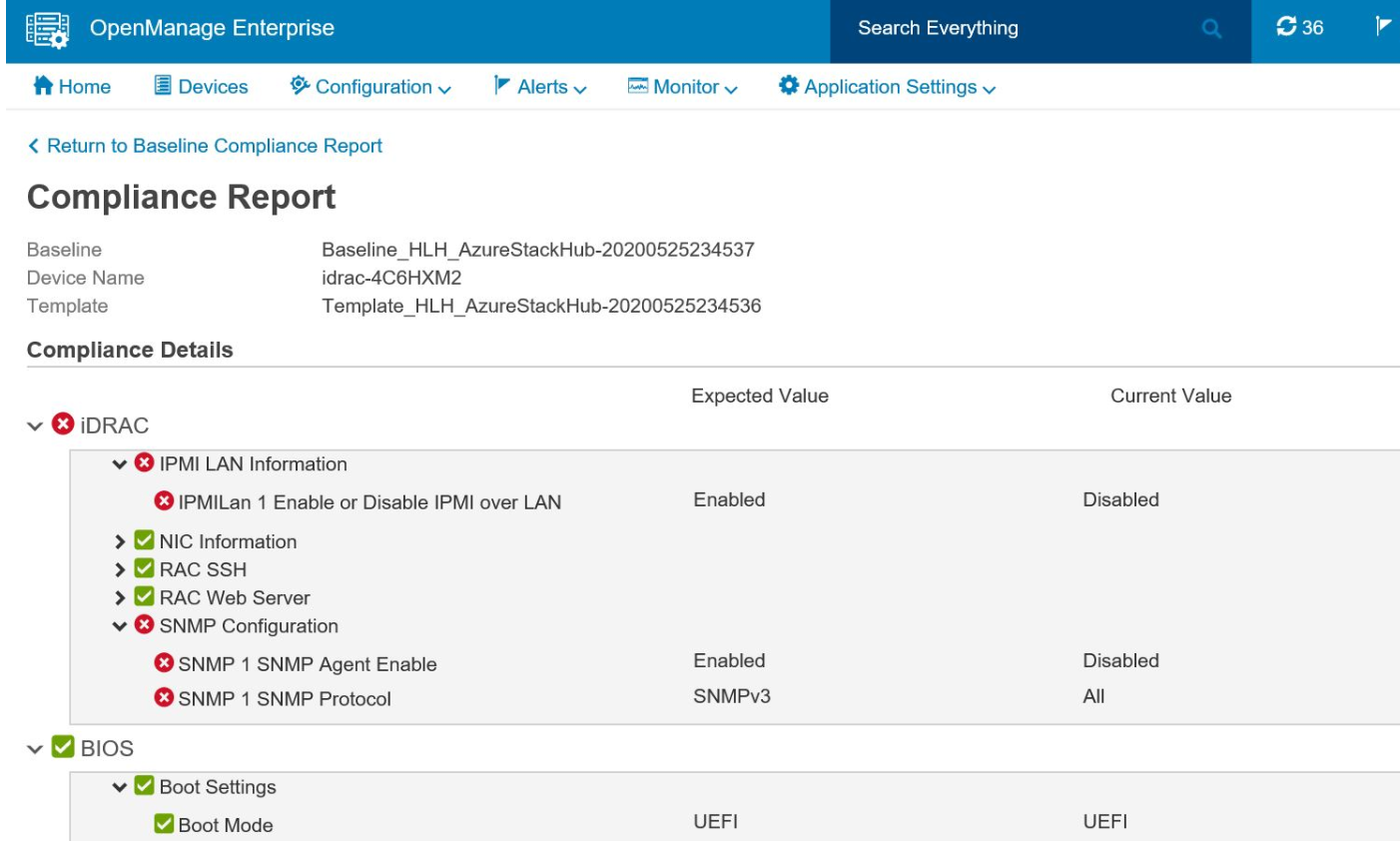
Future updates to the compliance baseline are seamlessly applied by means of the Dell EMC Patch and Update Automation as customers update to the latest Dell EMC Customer Toolkit.
Stay tuned as we move the needle towards a well-rounded compliance experience for our customers with similar features on ToR and Management switches in upcoming releases.
Related Blog Posts

The challenging Edge: Dell Technologies to the rescue with Azure Stack Hub – Tactical
Mon, 26 Jul 2021 12:46:04 -0000
|Read Time: 0 minutes
Some context for a turbulent environment
In August 31, 2017, Microsoft launched Azure Stack Hub and enabled a true hybrid cloud operating model to extend Azure services on-premises. An awesome and long expected milestone at that time!
Implementing Azure Stack Hub in our customers’ datacenters under normal circumstances is a pretty straightforward process today if you choose our Dell EMC Integrated System for Microsoft Azure Stack Hub.
But there are certain cases where delivering Azure Stack Hub may be complex (or even impossible), especially in scenarios such as:
 Edge scenarios: semi-permanent or permanent sites where there is no planned decommissioning, that can include:
Edge scenarios: semi-permanent or permanent sites where there is no planned decommissioning, that can include:
- IoT Applications: Device provisioning, tracking and management applications
- Efficient field operations: Disaster Relief, humanitarian efforts, embassies
- Smarter management of mobile fleet assets: Utility and maintenance vehicles

- Tactical scenarios: strategic sites stood up for a specific task, temporary or permanent, that can experience:
- Limited/restricted connectivity: submarines, aircraft, and planes
- Harsh Conditions: combat zones, oil rigs, mine shafts
The final outcome in these environments remains the same: provide always-on cloud services everywhere from a minimal set of local resources.
The question is… how do we make this possible?
The answer is: Dell EMC Integrated System for Microsoft Azure Stack Hub – Tactical
Dell Technologies, in partnership with Microsoft and Tracewell Systems, has developed Dell EMC Integrated System for Microsoft Azure Stack Hub – Tactical (aka Azure Stack Hub – Tactical): a unique ruggedized and field-deployable solution for Azure Stack tactical edge environments.
Azure Stack Hub – Tactical extends Azure-based solutions beyond the traditional data center to a wide variety of non-standard environments, providing a local Azure consistent cloud with:
- Limited or no network connectivity
- Fully mobile, or high portability (“2-person lift”) requirements
- Harsh conditions requiring military specifications solutions
- High security requirements, with optional connectivity to Azure Government and Azure Government Secret
Azure Stack Hub – Tactical is functionally and electrically identical to Azure Stack Hub All-Flash to ensure interoperability. It includes custom engineered modifications to make the whole solution fit into just three ruggedized cases that are only23.80 inches wide, 41.54 inches high, and 25.63 inches deep.
The smallest Azure Stack Hub – Tactical configuration comprises one management case plus two compute cases, each of them containing:
- Management case:
- 1 x T-R640 HLH management server (2U)
- 1 x N3248TE-ON management switch (1U)
- 2 x S5248F-ON Top-of-Rack switches (1U each)
- Total weight: 146 lbs.
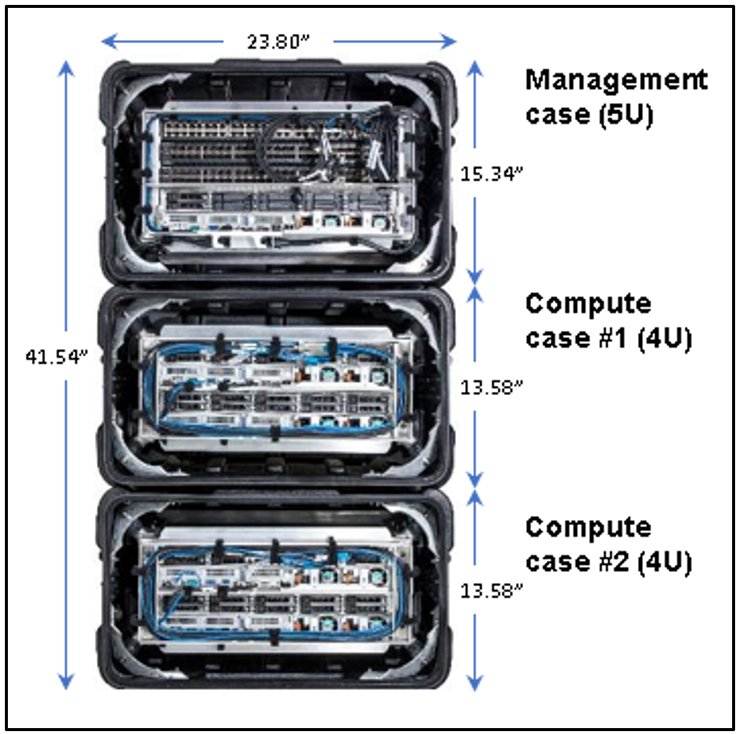
- Compute case:
2 x T-R640 servers, based on Dell EMC PowerEdge R640 All-Flash server adapted for tactical use (2U each)
Two configuration options for compute servers:
- Low:
- 2 x Intel 5118 12-core processors
- 384 GB memory
- 19.2TB total raw SSD capacity
- High:
- 2 x Intel 6130 16-core processors
- 768GB memory
- 38.4TB total raw SSD capacity
- Total weight: 116 lbs.
- Heater option for extended temperature operation support:
- The Tactical devices are designed to meet MIL-STD-810G specification
- Dell Technologies in collaboration with Tracewell systems has designed a fully automated heater which, when fully integrated, can provide supplemental heating to the device when needed.
Compute cases can grow up to 8, for a total of 16 servers (in 4-node increments) -- the scale unit maximum mandated by Microsoft.
You can read the full specifications here.
Azure Stack Hub – Tactical is a turnkey end to end engineered solution designed, tested, and sustained through the entire lifespan of all of its hardware and software components.
It includes non-disruptive operations and automated full stack life cycle management for on-going component maintenance, fully coordinated with Microsoft’s Update process.
Customers also benefit from a simplified one call support model across all solution components.
Conclusion
Desperate “edge-cuts” must have desperate “tactical-cures”, and that is exactly what Dell EMC Integrated System for Microsoft Azure Stack Hub – Tactical delivers to our customers for edge environments and extreme conditions.
Azure Stack Hub – Tactical resolves the challenges of providing Azure cloud services everywhere by allowing our customers to add/remove deployments with relative ease through an automated, repeatable, and predictable process requiring minimal local IT resources.
Thanks for reading and stay tuned for more blog updates in this space by visiting Info Hub!

GPU-Accelerated AI and ML Capabilities
Mon, 14 Dec 2020 15:37:06 -0000
|Read Time: 0 minutes
Dell EMC Integrated System for Microsoft Azure Stack Hub has been extending Microsoft Azure services to customer-owned data centers for over three years. Our platform has enabled organizations to create a hybrid cloud ecosystem that drives application modernization and to address business concerns around data sovereignty and regulatory compliance.
Dell Technologies, in collaboration with Microsoft, is excited to announce upcoming enhancements that will unlock valuable, real-time insights from local data using GPU-accelerated AI and ML capabilities. Actionable information can be derived from large on-premises data sets at the intelligent edge without sacrificing security.
Partnership with NVIDIA
Today, customers can order our Azure Stack Hub dense scale unit configuration with NVIDIA Tesla V100S GPUs for running compute-intensive AI processes like inferencing, training, and visualization from virtual machine or container-based applications. Some customers choose to run Kubernetes clusters on their hardware-accelerated Azure Stack Hub scale units to process and analyze data sent from IoT devices or Azure Stack Edge appliances. Powered by the Dell EMC PowerEdge R840 rack server, these NVIDIA Tesla V100S GPUs use Discrete Device Assignment (DDA), also known as GPU pass-through, to dedicate one or more GPUs to an Azure Stack Hub NCv3 VM.
The following figure illustrates the resources installed in each GPU-equipped Azure Stack Hub dense configuration scale unit node.
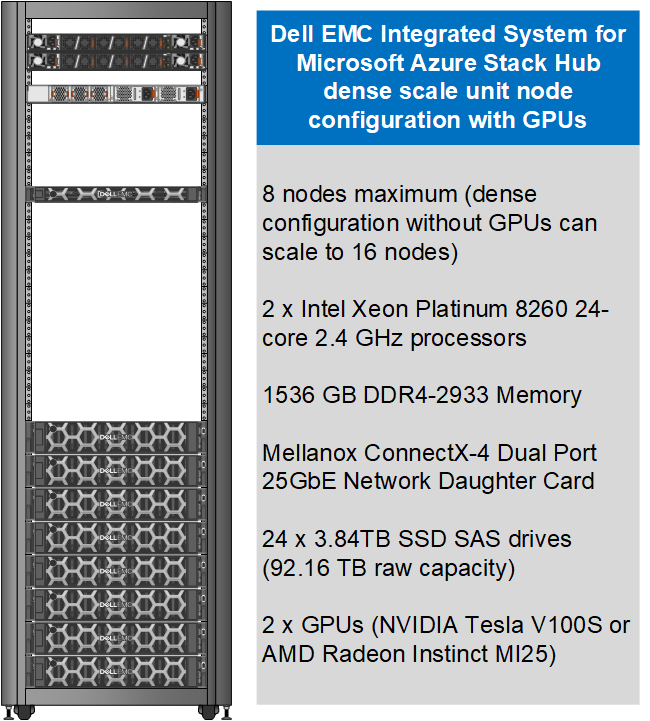
This month, our Dell EMC Azure Stack Hub release 2011 will also support the NVIDIA T4 GPU – a single-slot, low-profile adapter powered by NVIDIA Turing Tensor Cores. These GPUs are perfect for accelerating diverse cloud-based workloads, including light machine learning, inference, and visualization. These adapters can be ordered with Dell EMC Azure Stack Hub all-flash scale units powered by Dell EMC PowerEdge R640 rack servers. Like the NVIDIA Tesla V100S, these GPUs use DDA to dedicate one adapter’s powerful capabilities to a single Azure Stack Hub NCas_v4 VM. A future Azure Stack Hub release will also enable GPU partitioning on the NVIDIA T4.
The following figure illustrates the resources installed in each GPU-equipped Azure Stack Hub all-flash configuration scale unit node.
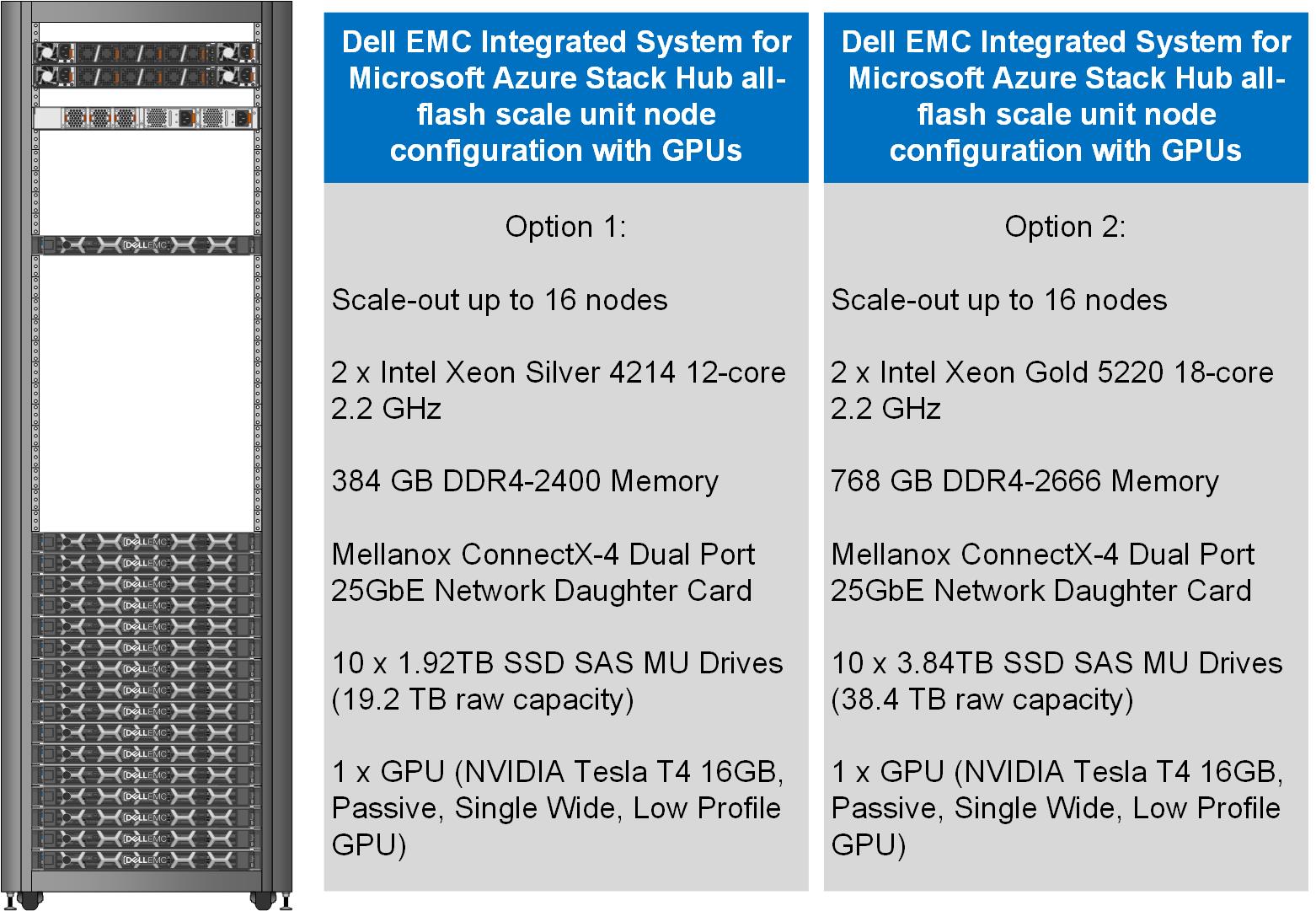
Partnership with AMD
We are also pleased to announce a partnership with AMD to deliver GPU capabilities in our Dell EMC Integrated System for Microsoft Azure Stack Hub. Available today, customers can order our dense scale unit configuration with AMD Radeon Instinct MI25 GPUs aimed at graphics intensive visualization workloads like simulation, CAD applications, and gaming. The MI25 uses GPU partitioning (GPU-P) technology to allow users of an Azure Stack Hub NVv4 VM to consume only a portion of the GPU’s resources based on their workload requirements.
The following table is a summary of our hardware acceleration capabilities.
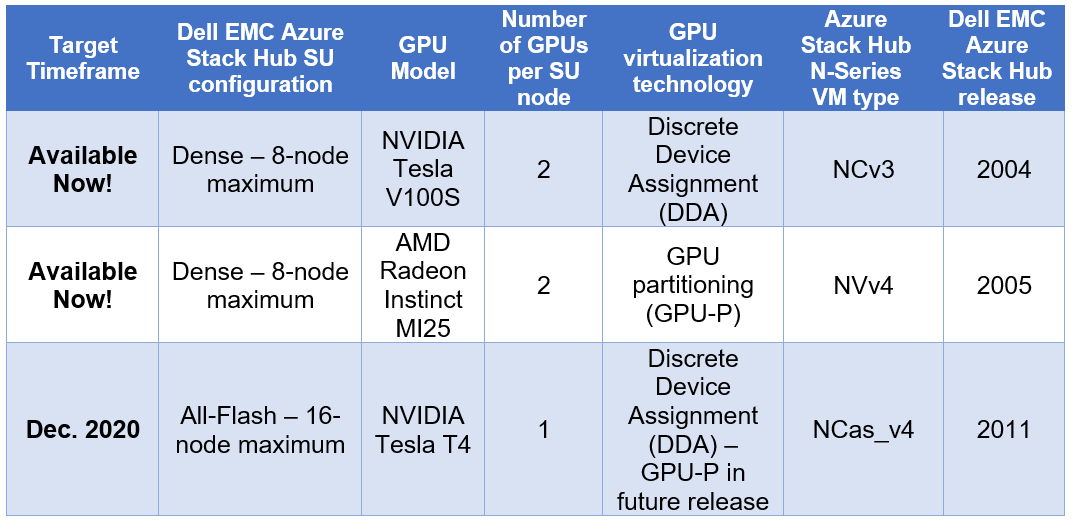
An engineered approach
Following our stringent engineered approach, Dell Technologies goes far beyond considering GPUs as just additional hardware components in the Dell EMC Integrated System for Microsoft Azure Stack Hub portfolio. We apply our pedigree as leaders in appliance-based solutions to the entire lifecycle of all our scale unit configurations. The dense and all-flash scale unit configurations with integrated GPUs are designed to follow best practices and use cases specifically with Azure-based workloads, rather than workloads running on traditional virtualization platforms. Dell Technologies is also committed to ensuring a simplified experience for initial deployment, patch and update, support, and streamlined operations and monitoring for these new configurations.
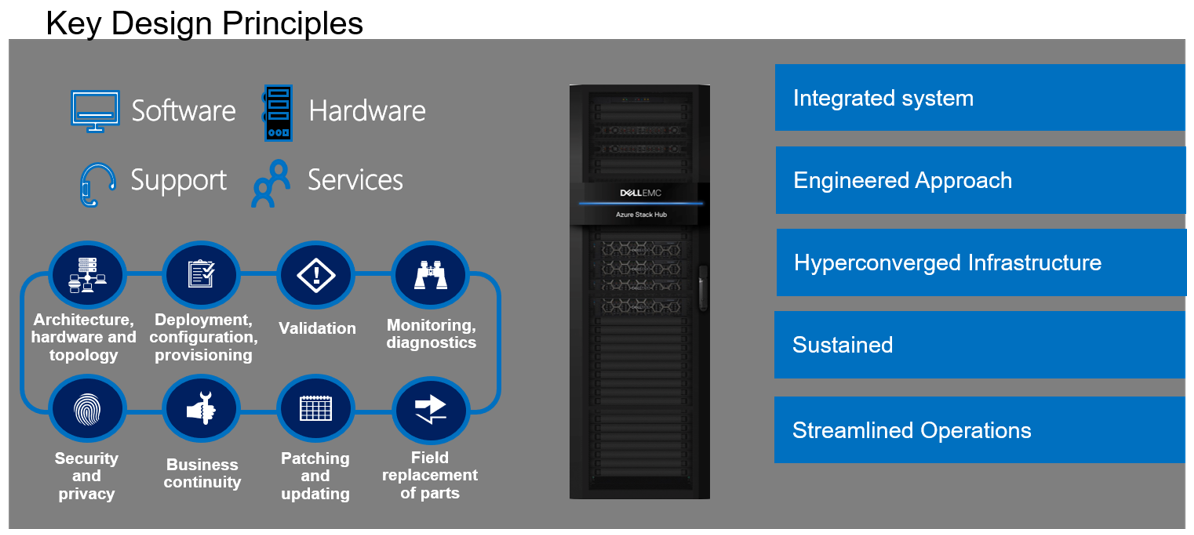
Additional considerations
There are a couple of additional details worth mentioning about our new Azure Stack Hub dense and all-flash scale unit configurations with hardware acceleration:
- The use of the GPU-backed N-Series VMs in Azure Stack Hub for compute-intensive AI and ML workloads is still in preview. Dell Technologies is very interested in speaking with customers about their use cases and workloads supported by this configuration. Please contact us at mhc.preview@dell.com to speak with one of our engineering technologists.
- The Dell EMC Integrated System for Microsoft Azure Stack Hub configurations with GPUs can be delivered fully racked and cabled in our Dell EMC rack. Customers can also elect to have the scale unit components re-racked and cabled in their own existing cabinets with the assistance of Dell Technologies Services.
Resources for further study
- At the time of publishing this blog post, only the NCv3 and NVv4 VMs are available in the Azure Stack Hub marketplace. The NCas_v4 currently is not visible in the portal. Please proceed to the Azure Stack Hub User Documentation for more information on these VM sizes.
- Customers may want to explore the Train Machine Learning (ML) model at the edge design pattern in the Azure Hybrid Documentation. This may prove to be a good starting point for putting this technology to work for their organization.
- Customers considering running AI and ML workloads on Dell EMC Integrated System for Microsoft Azure Stack Hub can also greatly benefit from storage-as-a-service with Dell EMC PowerScale. PowerScale can help enable faster training and validation of AI models, improve model accuracy, drive higher GPU utilization, and increase data science productivity. Visit Artificial Intelligence with Dell EMC PowerScale for more information.


